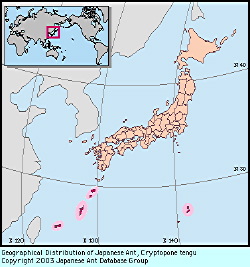
|
species
|
Cryptopone tengu
|
 |
Japanese Name
|
Hanadaka-hari-ari
|
Original Reference
|
|
Terayama, M. (1999) Taxonomic studies of the Japanese Formicidae, Part 4. Three new species of Ponerinae. Memoirs of the Myrmecological Society of Japan 1: 7-15.
|
Description
|
|
Total length of workers around 3.5 - 4 mm. Body color yellowish brown to reddish brown. Mandibles each with 8 teeth, the apical 4 larger than the others. Dorsal outline of clypeus distinctly produced, forming a right-angle in lateral view. Petiolar node thick; subpetiolar process present on anterior portion, forming a small rounded projection; the remaining ventral margin of petiole straight.
|
Remarks
|
|
This species resembles C. sauteri, but is easily distinguished by the configuration of the clypeus, petiolar node, and subpetiolar process. Cryptopone sp. of Onoyama (1976) and C. sp. 2 in Myrmecological Society of Japan Editorial Committee (1989) correspond to this species. It is distributed on Amami-oshima Island and southwards, and nests in the leaf litter and soil in forests. Relatively common in the Nansei Islands.
|
|

Distribution
|
|
Nansei Is (Amami-oshima I. and southwards), Ogasawara Is.
|
|
References
|
|
- Terayama, M. (1999). Taxonomic studies of the Japanese Formicidae, Part 4. Three new species of Ponerinae. Memoirs of the Myrmecological Society of Japan 1: 7-15.
- Onoyama, K. (1976). A preliminary study of the ant fauna of Okinawa-Ken, with taxonomic notes. (Japan: Hymenoptera: Formicidae). . Ecol. Stud. Nat. Cons. Ryukyu Isl., 2, 121-141.
- Myrmecological Society of Japan, Editorial Committee (ed.) (1989). A guide for the identification of Japanese ants (I). Ponerinae, Cerapachyinae, Pseudomyrmecinae, Dorylinae and Leptanilinae (Hymenoptera: Formicidae). The Myrmecological Society of Japan, Tokyo.
|
Editor
|
|
Original text by Mamoru Terayama and Keiichi Onoyama. English translation by Mamoru Terayama, edited by Robert W. Taylor.
|
|